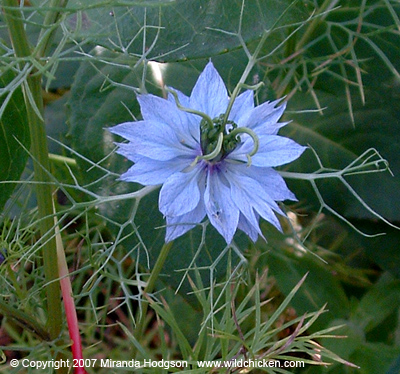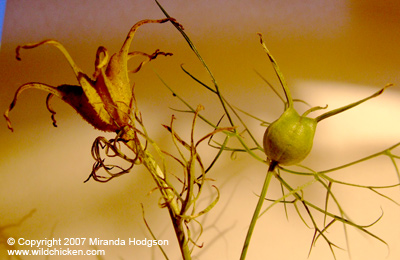


Seed pods ofNigella hispanica (l.) and Nigella damascena (r.)
Nigella damascena (also called Love-in-a-mist).
Nigella
damascena
Hardy annual grown for richly coloured blue or white flowers, followed by interesting seed pods, and delicate spidery foliage. The dried seed pods are useful for indoor arrangements. The most well-known variety is 'Miss Jekyll'.
Nigella damascena is attractive to beneficial insects such as bees and hoverflies.
Nigella damascena is similar to Nigella hispanica and the two are easily confused on first glance, especially when in flower. The easiest way to tell them apart is by the seed pods, which are quite different. The seed pod of N. damascena is an inflated capsule while N. hispanica's seed pod has more sections and several filaments that rise and twist, like a corkscrew, from the top of the pod.
N. damascena is also confused with the similar Nigella sativa. The seed of N. sativa is the source of the spice (the seed of the flower) known as Kalonji, or black onion seed, which is used to flavour breads and vegetable dishes in Asia.
Flowers in summer, seed pods in autumn.
1. Habit - upright. H: approx 40cm. S: up to 25cm.
2. Stem - slender, straight, smooth, mid-green.
3. Leaves - mid-green, deeply and finely dissected and spidery-looking.
4. Flowers - 5 sepals and generally 5-10 tiny petals at the base of the stamens. Arching stamens and twisting stamen filaments. The fine spidery hair-like growths just below the flower are actually bracts and not leaves.
5. Seed pods - an inflated capsule topped by usually three or four, twisting stamen filaments.
Full sun is best.
Well-drained/light.
Hardy.
Little needed. Plants can be dead headed to prolong flowering or left to form attractive seed pods.
Generally untroubled by pests or diseases.
By fresh seed, in situ (seedlings dislike disturbance), in autumn or spring. Plants will self-sow on their own.
Garden Plant Information list of plant care info by botanical name